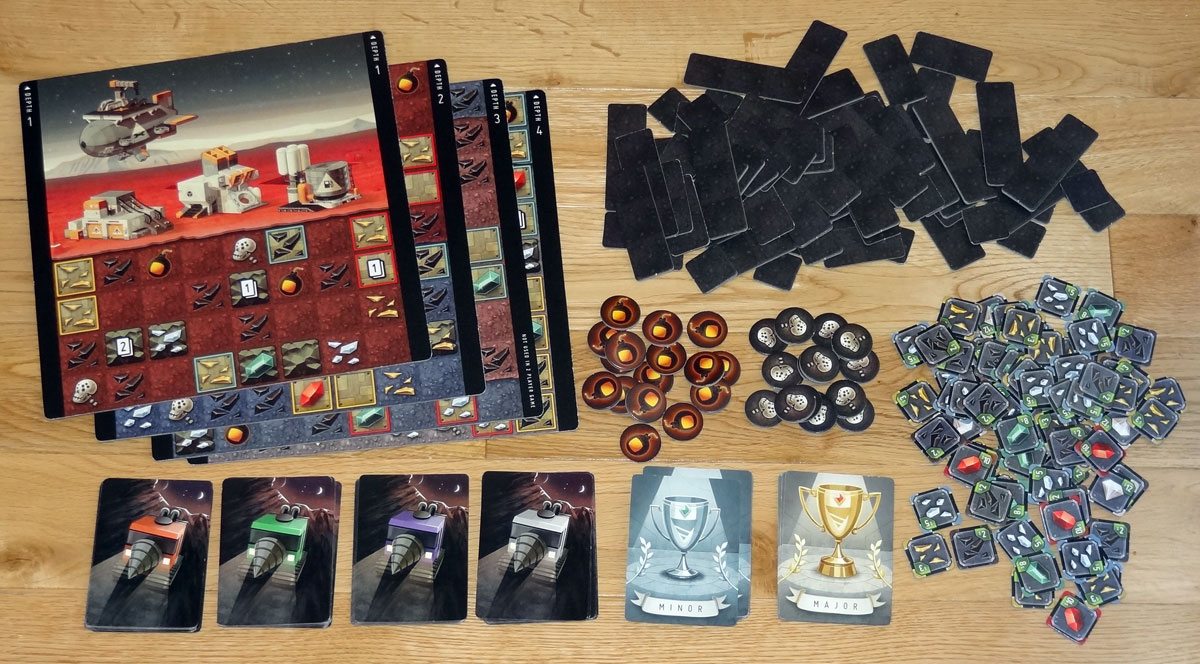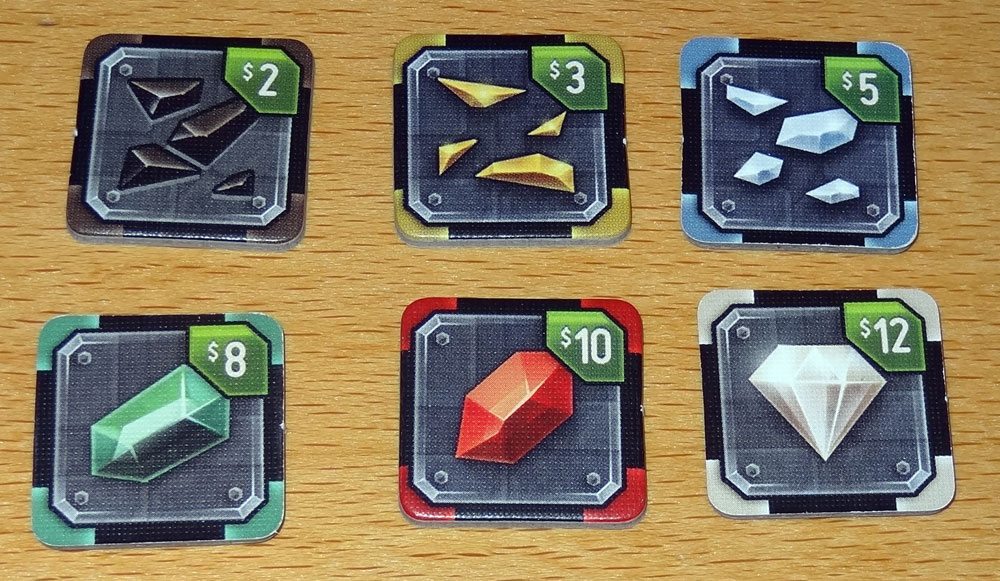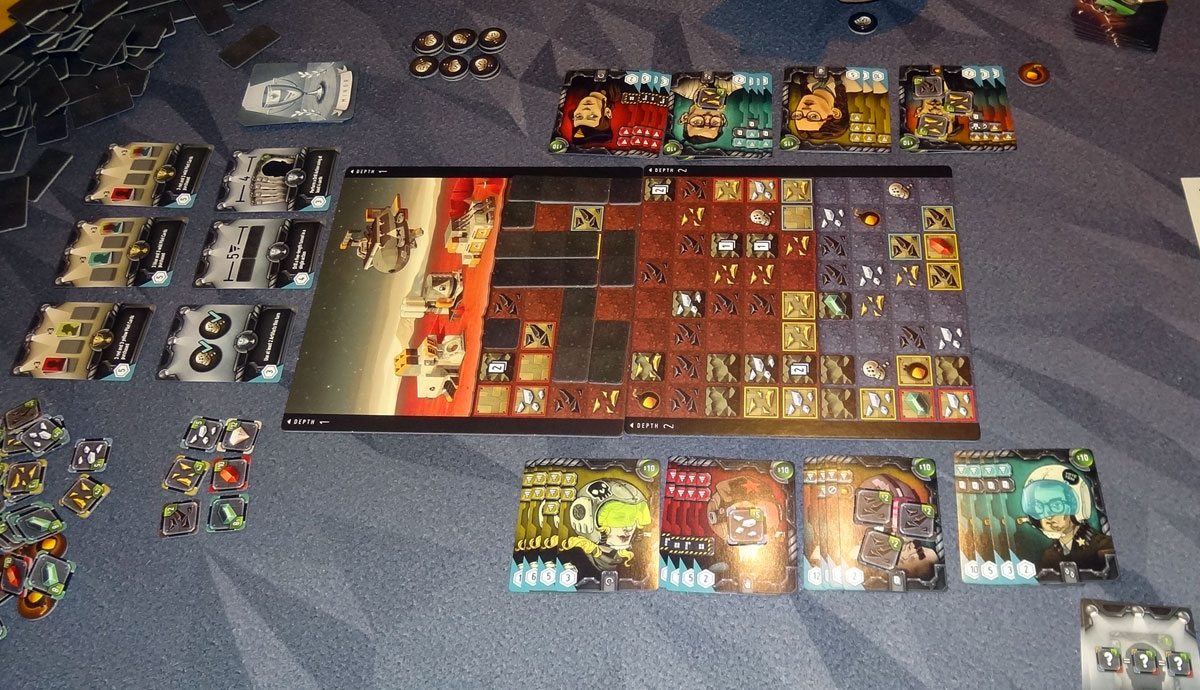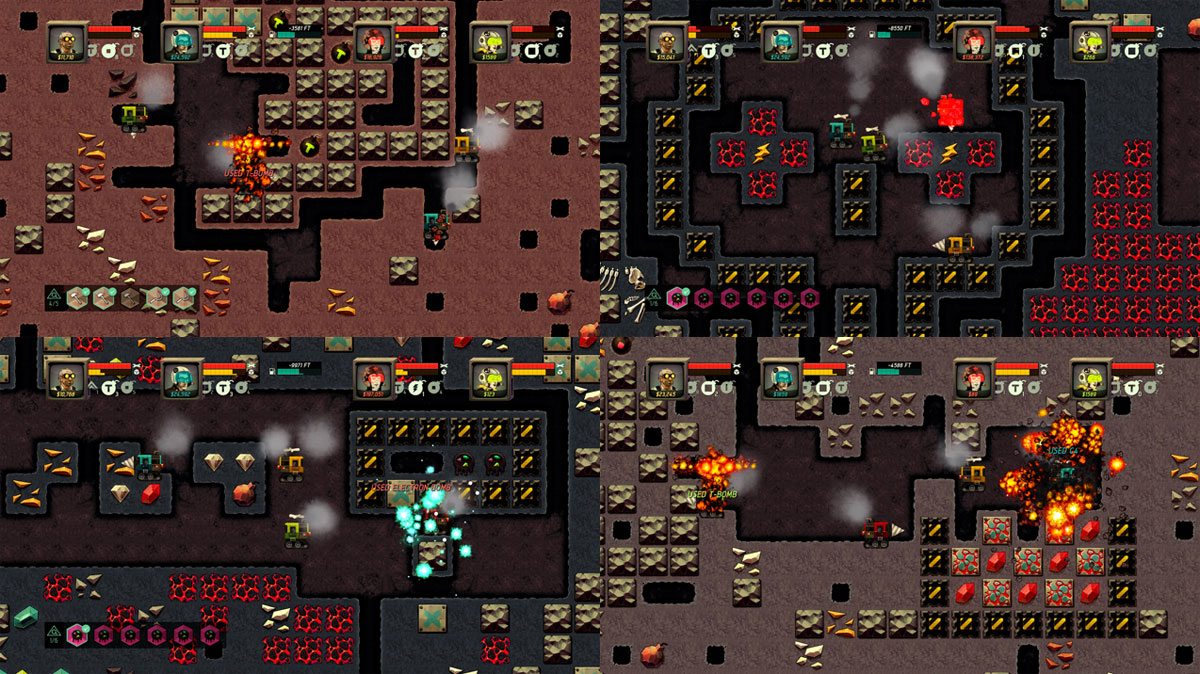In 2004, there was a Flash game about mining on Mars called Motherload. This inspired a 2011 board game by Matt Tolman and Gavan Brown, Undermining. A couple years later, when XGen Studios launched a Kickstarter campaign for an updated, multi-player version called Super Motherload, they teamed up with Tolman and Brown to make an officially licensed board game.
At a glance: Super Motherload is for 2 to 4 players, ages 13 and up, and takes about 75 minutes to play (depending on number of players). It retails for $49, and is available from Roxley Games or Amazon. I think the game could be played by younger kids who have the patience for it; it does include some deck-building and resource management, and there isn’t really anything in the game that isn’t kid-safe.

Components:
- 20 Minor Achievement cards
- 10 Major Achievement cards
- 92 Player cards (4 decks, 23 cards each)
- 16 Bomb tokens
- 16 Artifact tokens
- 76 Tunnel tiles (3 lengths)
- 80 Mineral tiles (6 denominations, double-sided)
- 4 double-sided game boards

The tokens are all nice, sturdy cardboard and they punch out cleanly (which is nice, because there’s a lot to punch out). There are four game boards, representing increasing depth, and they’re double-sided with different configurations of rocks and minerals on each side.

The square mineral tiles show the six different types of minerals (matching the ones shown on the game boards), with the dollar values in the corner. The weird thing, though, is that these are also double-sided with a different mineral on the back. That means that you have to be particularly careful not to flip over mineral tiles after you’ve earned them, or else you’ll be changing the value.

One thing I really liked about Super Motherload is the illustrations–in particular, the pilots. Each player gets their own deck of cards, with four types of pilots (yellow, red, blue, and multicolored). What’s really fun, though, is that each of the four player decks has its own four pilots. (I’m particularly fond of the bird-man seen above.) What’s more, the card bonuses (the small icon at the bottom center of each card) also vary from deck to deck, so there are asymmetric powers in the game.
The cards themselves are a decent quality–mine were slightly curved but nothing too severe. The four player decks have different colors on the backs so you can sort them easily. Overall, the iconography is pretty easy to interpret once you’ve played a little while. There are a couple icons that are more rare, and you’ll probably need to look those up the first few times you encounter them.
Helpfully, the back page of the rulebook lists all of the various icons with their meanings.
How to Play
You can download a copy of the rulebook here.
The object of the game is to score the most points by buying cards and getting achievements. Some artifacts may also award points.

To set up, you start with the first board (which shows the surface of Mars) on the table. The Major Achievements are shuffled and three are set face-up near the board, with the rest returned to the box. The Minor Achievements are shuffled and three are set face-up, with the rest forming a draw pile. Artifact tokens are all turned face-down and mixed up. The rest of the tokens are placed nearby as a supply.
Each player gets a deck of cards, and separates the 7 starting cards (which have no point value) from the rest. The starting cards are shuffled together to form your deck. You’ll each have your own deck of cards and discard pile; if your deck runs out, you shuffle your discard pile to form a new deck.
The other cards are arranged into four stacks, sorted by color and then placed with the highest cost at the bottom. Each player will have four stacks in front of them like this.

You don’t have to fan out the cards like this, but it can be helpful to know the costs and point values of each. The cost is the green dollar amount at the top right, and the point value is the white hexagon at the bottom left.
Each player takes 1 bomb token and draws a hand of four cards.
On your turn, you get two actions, which can be spent to Draw, Drill, or Bomb. (You can do the same action twice.) Then, if you have more than 5 cards in your hand, you discard down to 5,
Draw: Draw 2 cards from your deck into your hand.
Drill: Play any number of drill cards of the same color. (Multicolored drills are wild.) The total number of drill icons played indicates how long a tunnel you can drill, and you place tunnel tiles in a straight line covering that many spaces. You collect anything covered by the tunnel–minerals, artifacts, and other bonuses. You also get any bonuses shown on the left side of the cards you played.
Bomb: Spend a bomb token, and play a red pilot card. Red pilot cards have a little bomb pattern on the lower left side–you place tunnel tokens to match that shape (in any orientation), and collect anything those tokens cover.

When you play tunnel tiles (from drilling or bombing), they must somehow connect back to the surface, but otherwise you can play anywhere on the board. There are some other rules–tunnel tokens can’t overlap existing tunnels, nor can they hang over the edge of the board. Finally, there are different types of terrain: steel plates can only be drilled by the color matching the outline and cannot be bombed; rocks cannot be drilled and must be bombed.
Whenever somebody claims the last artifact tile on a board, the next board is attached and becomes available for drilling. When you attach the third board, you can clear off the first one and return tunnel tiles to the supply. (In this game, you never go back to the surface.)
Each time you collect minerals from drilling or bombing, all of the mineral tiles from a single action must be placed on one of your four pilot stacks. The values of the minerals count toward purchasing the pilot card–and you don’t get change if you overpay. As soon as the value of the minerals meets the cost of the pilot card, you return all of the minerals and take the pilot card, putting it into your discard pile.
Most of the pilot cards also have “buy bonuses” indicated by the icon at the bottom center. You may get an extra action, or get to put the card directly into your hand, or even clone a mineral tile on one of your other stacks.

Artifact tokens are gained when you dig through an artifact on the board–the tokens show the multi-eyed skull on one side, and a bonus icon of some sort on the other. You can save artifact tokens to use on any turn, and they do not cost an action to use.

There are 3 Major Achievements and 3 Minor Achievements that can be earned if you fulfill the requirements during your turn. Only one of each type of achievement may be earned each turn. Minor Achievements are replenished from the draw pile when somebody takes one, but there are only 3 Major Achievements available in the game.
The game ends when somebody claims the last artifact on the last board. That player finishes out the turn. Then everyone adds up all of their points: all of the pilot cards they bought, any achievements earned, and any artifacts that are worth bonus points. Highest score wins.

The Verdict
I’d heard of the videogame version of Super Motherload and watched some clips of gameplay, but hadn’t ever played it before. I hadn’t even played the original Flash game until just recently, either. But I liked the theme, and I’m always interested in seeing new ways of using deck-building in games, so I was eager to give this a try.
I’ve played a few times now, and I’ve really enjoyed it. It’s a good mix of deck-building and tile-laying, and isn’t exactly like any other games I’ve played before.
First, the deck-building: probably my least favorite part is sorting and laying out the cards at the beginning. Granted, I try to sort them out when I put the game away so they’ll be ready to go quickly, but the first time I played it seemed a bit odd for each player to sort out 16 cards and get them all organized. For a four-player game, it does take up a good amount of space, what with the 16 piles of cards, 4 draw decks, 6 achievements, up to 2 boards, and piles of tokens everywhere.

However, I did like the results of that involved setup. First, the higher-scoring cards are also the more expensive ones. Since you have to buy them in order, top to bottom, this means that you have to decide if you’re going to specialize in one stack, or spread out and buy several of the cheap cards so you can build your deck more quickly. There are pros and cons to both, of course. Having more cards of the same color will increase the chances that you can drill a really long tunnel in a single action–but at the same time, it limits the different colored steel plates you’ll be able to drill through.
The cards also have different drill bonuses, and these vary from player to player. One color might give you an extra card draw when you play it. One player has the ability to drill through rock; another can gain bombs while drilling. Part of the strategy is making the most of your deck’s particular strengths.
Unlike many deck-building games, you don’t acquire cards quite as quickly–it takes you some time to build up the minerals to buy something, and sometimes you may even delay buying right away so you can earn a particular achievement. At most, even if you do manage to purchase all of your cards (something I’ve never seen happen), it’s still only 23 cards total. So while it is a deck-building game, the building is slow and isn’t the only thing you’ll need to pay attention to.
That brings us to the drilling. Because of the various spots on the board–rocks, steel plates, artifacts, valuable minerals–you’ll have to find ways to dig to the things you want from the existing tunnels (and the surface). But, of course, you don’t want to dig a tunnel near something valuable and then leave it, because chances are somebody else will get to it before your next turn. Balancing out how much you can take and how easy you want to make it for the next player is a constant tension. There are also ways that you can make it very difficult for anyone to get to a particular spot without wasting a lot of cards or actions to do so.
In deck-building games, one of the primary complaints was the feeling of playing “multiplayer solitaire”–that is, everyone is pretty much doing their own thing without a lot of ways to directly influence another player. Not so in Super Motherload: everything you do affects the next player’s potential actions. In that sense, it reminds me a little bit of Trains, which also mixes individual deck-building with a shared board. The downside, though, is that it can sometimes feel a bit too chaotic, particularly in a four-player game, because there’s no way to plan your next move ahead of time. The state of the board can change too much by then.
The achievements are also a fun wrinkle. Just like videogame achievements, you can get rewarded for doing things that aren’t always in your best interest. But these can help direct your actions if you find yourself getting stuck on a move. If you can’t get to the minerals you want, maybe you could score some points for having several low-value iron tiles on your stacks. Want a Major Achievement? You’ll have to focus on buying several cards of the right types.
All in all, I really enjoy Super Motherload and most of the people I’ve played it with have been keen to play it again. I certainly think I’ll need several more plays to nail down strategies, and I like the fact that each deck is slightly different, so there may not be a one-size-fits-all path to winning. I like the look of the game (not everyone in my group liked the pilot portraits) and I think the game is pretty easy to learn. There’s a lot going on in the game, but it feels well-integrated. Regardless of whether you’ve played the videogame, if you want a new spin on deck-building, you might like Super Motherload.
Disclosure: I received a copy of this game for review.





